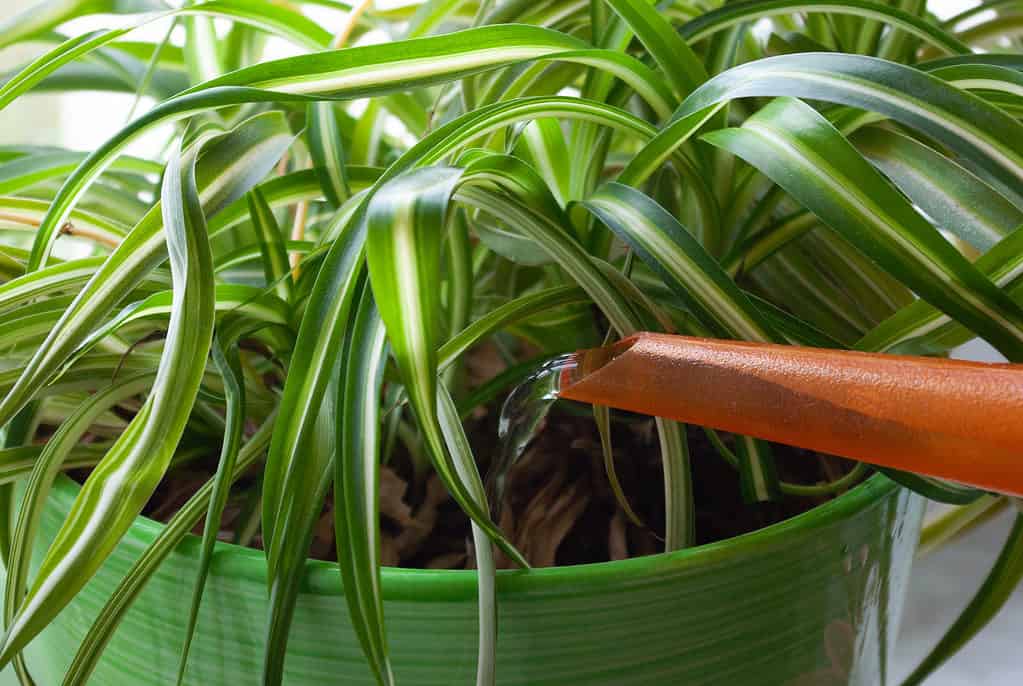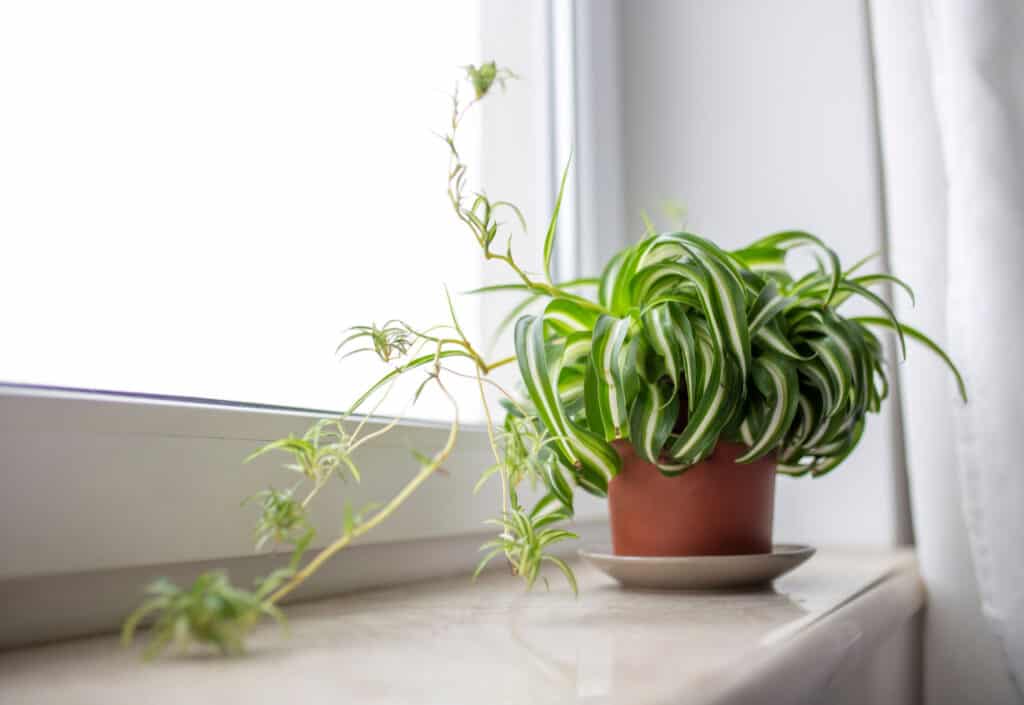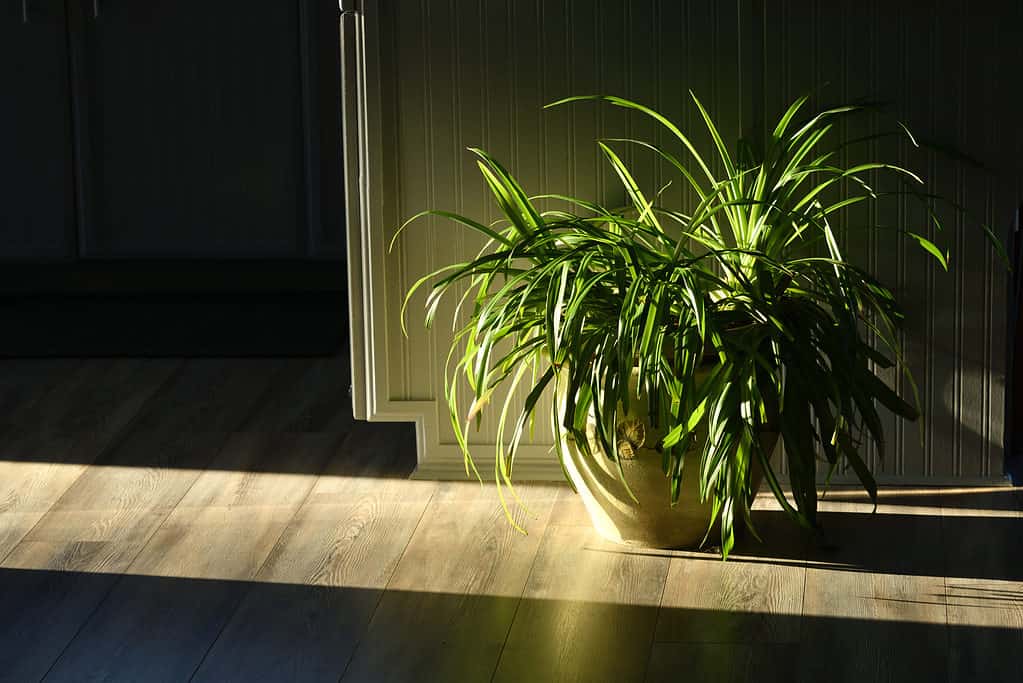The wonderfully unique spider plant is an attractive indoor plant from sunny southern Africa. Due to its unique ability to filter air and its therapeutic qualities, it is a popular indoor plant. It has long, spindly, arching leaves that can be either solid green or have white or pale green variegation. Its name stems from its spider-like leaves, which hang down from the mother plant like spiders on a web.
That being said, there are so many other benefits to the spider plant that don’t just involve its pretty appearance. In addition to its air purifying and medicinal benefits, tons of other great benefits are unique to this plant. Let’s explore why it is the perfect plant to keep in anyone’s home.
What is a Spider Plant?
The evergreen perennial herbs known as spider plants are commonly planted for their long, arched leaf. Southern Africa and the African tropics are home to spider plants. They are frequently cultivated in hanging baskets and may reach heights of 12 to 24 inches.
Chlorophytum comosum is the scientific name for spider plants, which are members of the Asparagaceae family.
The most prevalent varieties of spider plants have variegated leaves. These leaves are either dark green with white stripes on the outer or green with a white stripe in the middle.
Spider plants produce “spiderettes,” or plant babies that resemble spiders, along runners that emerge from the parent bush. Although they can withstand temperatures as low as 35 degrees F, spider plants thrive in temperatures between 65 and 90 degrees F. These plants can grow quickly and produce many small, white flowers when grown in the right conditions.
13 Benefits of the Spider Plant
1. Air Purification
This plant’s ability to filter and cleanse the air in your house is definitely the biggest benefit of spider plants. This non-toxic plant is ideal for removing airborne pollutants, including formaldehyde, toluene, and xylene. According to scientists, spider plants are among the greatest indoor plants for purifying the air. Spider plants performed better at air purification than a number of other plants in NASA’s 1989 Clean Air Study. Additionally, it has been demonstrated that spider plants can eliminate 95% of toxins from the air in just 24 hours.
Because of their cleansing qualities, spider plants are also the best choice for allergy patients. Some of the tiniest airborne irritants, including dust mites, pollen, mold spores, and others, can be removed by these incredible plants.

Regularly watering a spider plant (pictured) will boost the humidity in the air around it.
©iStock.com/Simplylesia
2. Increasing Humidity
Due to their ability to boost the humidity in any indoor space, spider plants are a fantastic addition to any home or business. You’ll find that your windows will have more condensation if spider plants are positioned next to them.
When water evaporates, the water droplets left behind after this plant has been watered create humidity for up to 12 hours. Spider plants frequently have a large number of leaves that offer shade over heated surfaces, which reduces moisture loss throughout the summer. When indoor humidity ranges from 40% to 60%, the plant thrives, which has the added benefit of maintaining a humid environment in your house.
3. A Unique Food Source
Because they are edible, spider plants are excellent for both indoor and outdoor gardening. Spider plants get their name from how their roots spread outward from a central location. In low-moisture conditions, they develop fleshy, upright roots that spread outward and retain more water and nutrients.
Despite being uncommon among American grocery stores, the roots and leaves of this plant are both tasty. Spider plant leaves can be cooked as a side dish or added to salads. Furthermore, they have a mild flavor, which makes them ideal for use in meals like stir-fries, egg bakes, casseroles, green smoothies, and more.
4. Safety
Spider plants are among the greatest child and pet-friendly houseplants for your home because they are non-toxic. When caring for young children and maintaining a natural, green interior atmosphere, spider plants make excellent additions. While it is preferable to attempt to keep your children and pets from nibbling on your houseplants, accidentally eating a spider plant’s leaves or spiderettes is safe since they do not contain any hazardous poisons or chemicals that can cause illness or stomach upset.

Potted spider plants (pictured) can tolerate quite a bit of neglect.
©ArtCreationsDesignPhoto/Shutterstock.com
5. Hard to Kill
The spider plant is one of the few houseplants out there that can grow with minimal care. Even when left unattended for days, excessively watered, or not watered very often, it can survive and readily adapt to many climatic circumstances. Although it is advised to keep this plant in a location with strong indirect sunlight, the spider plant may also thrive in low light and partial sunlight.
6. Therapeutic Uses
In comparison to patients in rooms without the plant, multiple studies have found that adding the spider plant to hospital rooms hastens the recovery rate of surgical patients. Less pain medication is needed, no problems with blood pressure or heart rate, less anxiety or sadness, and the patients leave the hospital sooner.
Because there are so much spider plant benefits, such as lowering stress, depression, and anxiety, spider plants are considered quite therapeutic. This advantage is related to the plant’s capacity to purge pollutants and absorb carbon dioxide and toxins like formaldehyde and xylene, promoting a healthy living environment.
7. Toxin and Allergen Absorption
The spider plant can help eliminate airborne allergens, including dust mites, pollen, mold spores, pet dander, and more, making it beneficial for persons with allergies or chronic hay fever. These toxins no longer produce allergy responses when they are eliminated from the air. In this approach, spider plants function even further as air purifiers for the tiniest airborne contaminants that most air purifiers and scrubbers cannot eliminate from the air in indoor spaces.
8. Ozone Absorption
Ozone, a colorless gas made up of three oxygen atoms, is produced when sunlight reacts with oxides of nitrogen, also known as the combination or inclusion of sulfur oxide, nitrogen oxide, and water vapor. If breathed in in high quantities over extended periods of time, this gas may be detrimental to human health. Ozone is not dangerous to people unless it is absorbed into water droplets, where it is then broken down.
Because spider plants can breathe via their leaves and have a porous structure that allows for gas exchange, they are able to collect ozone from the air. However, this ability comes at a cost. By creating brown stains on the leaves of the plant, ozone harms spider plants and lessens their capacity to photosynthesize. In order for spider plants to adapt to their new habitat and develop a tolerance for these dangerous chemicals, it is better if they had been grown from seed in an ozone-free environment.
9. Aesthetics
The addition of color and liveliness to indoor environments is another fantastic benefit of spider plants. A thick rosette of long, thin, arching leaves that are either green or white, or both, distinguishes spider plants. The plant looks bold and attractive, especially when it is hung in bouquets of flowers, due to the variegation of the leaves. It was typical in Victorian-era homes because of this. By hanging spider plants from the ceiling, windows, or shelves in pots, they may be utilized to embellish indoor places like a living room or bedroom. They are also great for use as tabletop decorations.
10. Easy to Propagate
By spreading spider plants out, you can get the most out of them. You may easily develop new plants from older ones with the help of spider plants. The spiderettes that appear at the ends of the branches can quickly take root in damp potting soil. Place a few small pots around the main plant, then gently push a plantlet’s base into the soil of each pot to create additional spider plants. The spiderettes should root and be able to be separated from the parent after two to three weeks if the soil is kept as wet as possible. Continue to develop them in the tiny pots and transfer them to larger ones as needed.

The spider plant (pictured) is both aesthetically-pleasing and fantastic for improving the energy in your home.
©iStock.com/Greenseas
11. Excellent for Feng Shui Practitioners
According to the feng shui idea, harmony between the natural environment and its people may be achieved by arranging objects like towns, buildings, tombs, architectural designs, plants, furniture, and other things in certain places. Spider plants are seen as emblems of luck and fortune in feng shui and eastern cultures because of their natural, strong, and long vines. The vines represent steadfastness in life.
12. Lead Tolerance
Spider plants may thrive in lead-contaminated soil, while most other plants cannot. According to one study, spider plants might thrive in soils with up to 500mg of lead per kilogram of dry soil. Spider plants may be useful plants for lead phytoremediation, according to another study from Procedia Environmental Sciences. Spider plants offer the advantages of high biomass and low cost in addition to removing lead from the soil.
13. Low Maintenence
We mentioned earlier that spider plants are hard to kill, and they are also quite easy to maintain. The spider plant can be ideal for you if you frequently travel or don’t have a green thumb. They just need to be replanted every 18 months or so, don’t need much maintenance, and normally don’t have many pests or disease problems. If you like having your spider plants in roughly consistent shapes, little trimming will also maintain them that way.
Spider plants may live for brief periods in temperatures as low as 40o and can withstand a broad range of temperatures. They can endure brief dry conditions but prefer moderate to high humidity levels. The typical humidity level in a home is acceptable. You don’t have to worry about relocating them from one room to another because they are also highly adaptable.
They can also put up with the occasional underwatering or overwatering. That being said, you should water spider plants when the soil is just beginning to feel dry and fertilize them sometime in the spring and summer. The last point is that spider plants can adjust to a broad range of lighting conditions. They can thrive in regions with less light, although they prefer strong, indirect light.
How cool are all of these benefits of the spider plant? Keeping this unique plant doesn’t just add a touch of greenery to your space. It can also provide a ton of additional benefits that can make your home a more inviting and comfortable place to be. What’s not to love about the spider plant?
Do you want to learn even more about the incredible and resilient spider plant? Take a look at our complete guide to spider plants here!
The photo featured at the top of this post is © Bozhena Melnyk/Shutterstock.com
Sources
- NCSU Staff, Available here: https://plants.ces.ncsu.edu/plants/chlorophytum-comosum/
- Susan Mahr, Available here: https://hort.extension.wisc.edu/articles/spider-plant-chlorophytum-comosum/
- Alex K. Worley, Available here: https://gardenine.com/spider-plant-benefits/
FAQs (Frequently Asked Questions)
Can spider plants filter the air?
Yes. Spider plants can filter carcinogens like formaldehyde in the air of indoor spaces.
Is the spider plant considered lucky?
The spider plant is considered lucky and a bringer of good health in several eastern cultures.
Can spider plants affect humidity?
The spider plant can help you increase the humidity in your home, mainly by simply regularly watering the plant.
Thank you for reading! Have some feedback for us? Contact the AZ Animals editorial team.






